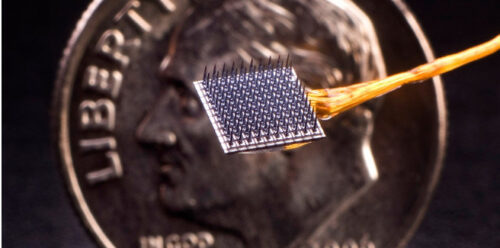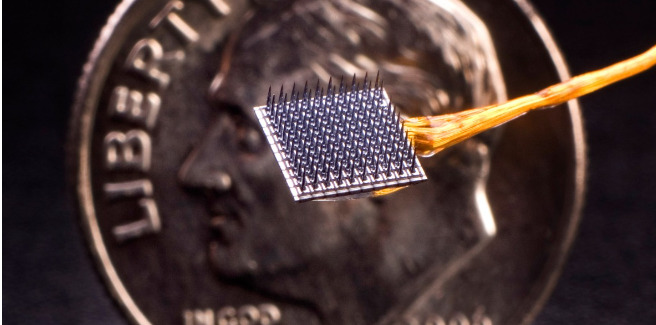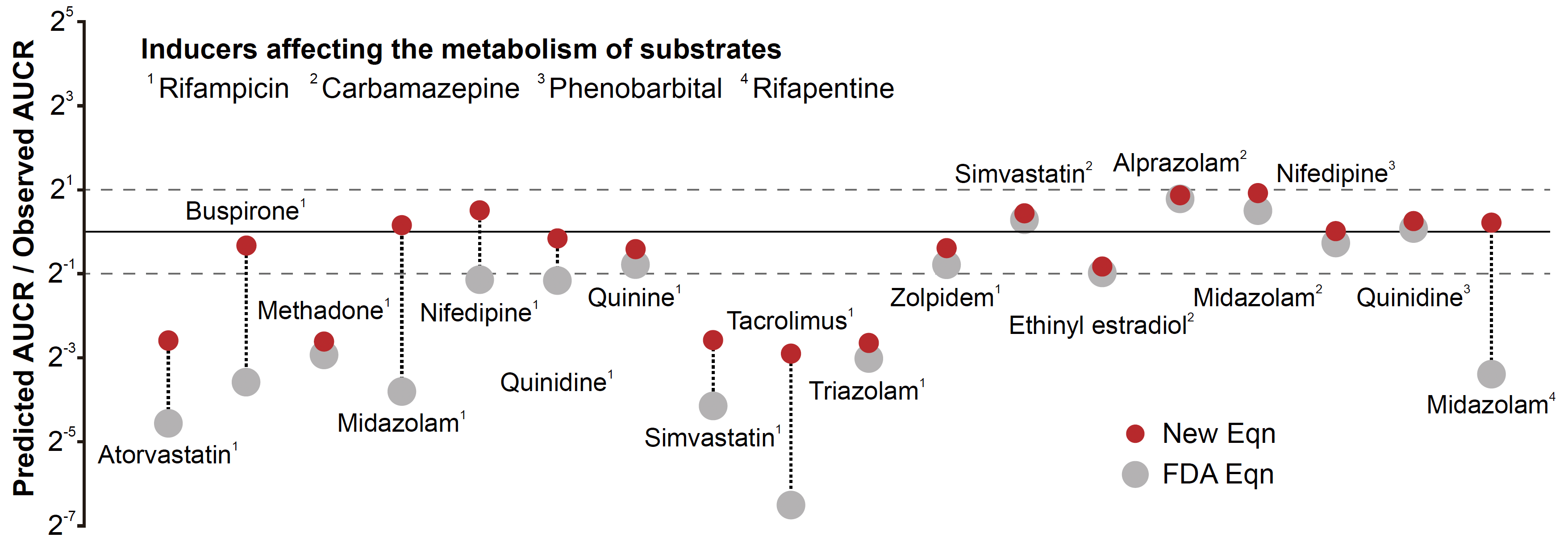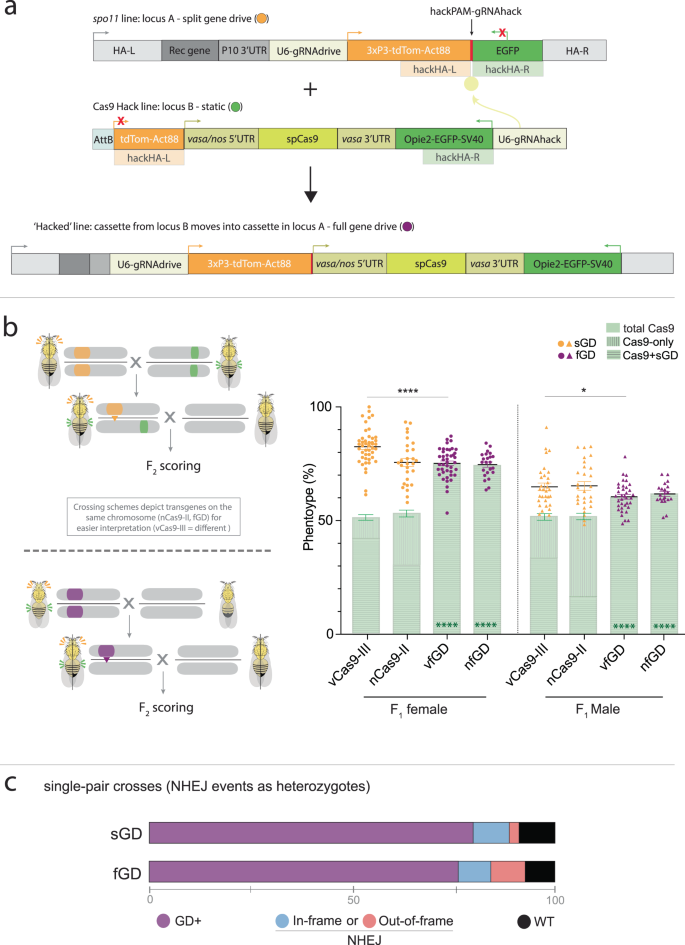神経インターフェースシステム「ブレインゲート」が有害事象の発生を抑制することを確認。 In an important step toward a medical technology that could help restore independence of people with paralysis, researchers find the investigational BrainGate neural interface system has low rates of associated adverse events.
2023-01-13 ブラウン大学

Brain-computer interfaces use tiny electrodes to record signals in the brain. Credit: BrainGate.org.
数十年の進歩を経て、研究者たちは、この有望な技術の安全性と、神経疾患や麻痺を患う人々が長期的に使用することの意味について、これまでで最高の見通しを得ている。
1月13日(金)にNeurology誌に掲載されたこの新しい研究は、ブレインゲート技術を試験した臨床試験の17年以上に及ぶ安全性データを分析したものです。その結果、ブレイン・コンピュータ・インターフェイス(BCI)に関連する有害事象の発生率は低く、この技術は、麻痺のある人が失われた神経機能を取り戻すのに役立つ可能性があるため、今後も評価を続けるべきであると結論づけました。
BrainGateデバイスは、手足の動きを制御する脳の一部に埋め込むBCIの一種です。ユタ」アレイと呼ばれる微小電極は、コンタクトレンズよりも小さく、運動野の表面に設置される。この電極は、意図した動作に関連する神経信号を検出し、近くにある小さなコンピューターに送り、そのコンピューターがアルゴリズムを使って信号を動作コマンドに変換することで機能する
BrainGateの最終的な目標は、四肢麻痺の人々のコミュニケーション、移動、自立を回復させることである。BrainGateの研究者は、これまでの研究で、BCIによってロボットの腕を動かしたり、麻痺した自分の腕や手を動かしたりできることを明らかにしている。
BrainGateの新しい試験では、脊髄損傷、脳幹部卒中、ALSに起因する四肢麻痺の臨床試験参加者14名の合計12,203日分の安全性データを評価しています。参加者の年齢は18歳から75歳で、2004年から2021年の間にBrainGate社の臨床試験に登録されました。最も多かったのは、脳に埋め込まれた神経センサーアレイを近くの神経解読システムに接続する、ユーザーの頭頂部にある装置の小さな部分の周囲の皮膚刺激でした。
<関連情報>
- https://www.brown.edu/news/2023-01-13/braingate-safety
- https://n.neurology.org/content/early/2023/01/13/WNL.0000000000201707
BrainGate神経インターフェースシステムのフィージビリティスタディにおける安全性プロファイルの中間報告 Interim Safety Profile From the Feasibility Study of the BrainGate Neural Interface System
Daniel B Rubin, A. Bolu Ajiboye, Laurie Barefoot, Marguerite Bowker, Sydney S. Cash, David Chen, John P Donoghue, Emad N Eskandar, Gerhard Friehs, Carol Grant, Jaimie M Henderson, Robert F Kirsch, Rose Marujo, Maryam Masood, Stephen T Mernoff, Jonathan P Miller, Jon A Mukand, Richard D Penn, Jeremy Shefner, Krishna V Shenoy, John D Simeral, Jennifer A Sweet, Benjamin L Walter, Ziv M Williams, Leigh R Hochberg
Neurology Published January 13, 2023
DOI: https://doi.org/10.1212/WNL.0000000000201707
Abstract
Background and Objectives: Brain computer interfaces (BCIs) are being developed to restore mobility, communication, and functional independence to people with paralysis. Though supported by decades of preclinical data, the safety of chronically implanted microelectrode array BCIs in humans is unknown. We report safety results from the prospective, open-label, non-randomized BrainGate feasibility study (NCT00912041), the largest and longest-running clinical trial of an implanted BCI.
Methods: Adults aged 18-75 with quadriparesis from spinal cord injury, brainstem stroke, or motor neuron disease were enrolled through seven clinical sites in the United States. Participants underwent surgical implantation of one or two microelectrode arrays in the motor cortex of the dominant cerebral hemisphere. The primary safety outcome was device-related serious adverse events requiring device explanation or resulting in death or permanently increased disability during the one-year post-implant evaluation period. Secondary outcomes include the type and frequency of other adverse events as well as the feasibility of the BrainGate system for controlling a computer or other assistive technologies.
Results: From 2004 – 2021, fourteen adults enrolled in the BrainGate trial had devices surgically implanted. The average duration of device implantation was 872 days, yielding 12,203 days of safety experience. There were 68 device-related adverse events, including 6 device-related serious adverse events. The most common device-related adverse event was skin irritation around the percutaneous pedestal. There were no safety events that required device explantation, no unanticipated adverse device events, no intracranial infections, and no participant deaths or adverse events resulting in permanently increased disability related to the investigational device.
Discussion: The BrainGate Neural Interface system has a safety record comparable to other chronically implanted medical devices. Given rapid recent advances in this technology and continued performance gains, these data suggest a favorable risk/benefit ratio in appropriately selected individuals to support ongoing research and development.
Trial Registration Information: ClinicalTrials.gov Identifier: NCT00912041.
Classification of Evidence: This study provides Class IV evidence that the neurosurgically placed BrainGate Neural Interface system is associated with a low rate of SAEs defined as those requiring device explanation, resulting in death, or resulting in permanently increased disability during the one-year post implant period.



